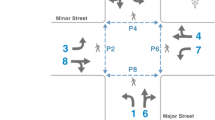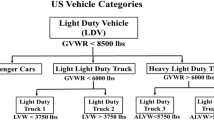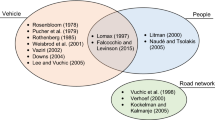Abstract
Traffic congestion has harmful implications on road users and leads to rise in both commuting time and the tendency of road rage, increasing the frequency of road crashes. At median openings (MO), due to complex movement of U-turns and approaching traffic, measurement and assessment of congestion is imperative. Identifying the level of congestion at median openings can help in strategizing location specific steps to ease the problem. In this study, the travel time reliability measures like planning time index (PTI) and travel time index (TTI) have been modified with relation to median opening by incorporating steady speed as compared to free flow speed used earlier. Video graphic analysis was conducted and speed data is extracted from 4500 vehicles travelling at different traffic volumes. PTI and TTI have been correlated with 95th, 85th, and 15th percentile speeds and have been used to develop the ranges of congestion severity index. It is observed that the congestion indices alone cannot justify the amount of congestion since their values saturated after a threshold traffic volume of 3000–4000 vph. 15th percentile speed along with the 85th and 95th percentile speeds gives a better picture of congestion since they encompass the slow moving vehicles too. The percentile speeds have been utilized to designate the congestion severity index by using k-mean clustering. Traffic situations where 95th, 85th, and 15th percentile speeds are below 39.6, 35.6, and 22.7 kmph, it can be attributed to severe traffic congestion whereas the same percentile speeds if are observed to be above 52, 46, and 31 kmph, the traffic flow can be represented as free flow/no sign of any congestion. The present study helps in categorizing traffic congestion at median openings in a rational way, thereby undertaking proper steps and actions to alleviate them. However, the results obtained are valid for median openings on 6-lane divided urban roads and the same methodology can be conducted for roads of different lane configuration for better understanding.





Similar content being viewed by others
Data Availability
All required data/material have been included in manuscript. Other data/material is necessary would be provided on request.
Abbreviations
- MO:
-
Median Openings
- PTI:
-
Planning Time Index
- TTI:
-
Travel Time Index
- CSI:
-
Congestion Severity Index
References
Reed, T., And Kidd, J.: INRIX Global Traffic Scorecard. Report, INRIX (2019)
Aftabuzzaman, M.: Measuring Traffic Congestion-A Critical Review. In 30th Australasian Transport Research Forum. (2007), September
Afrin, T., Yodo, N.: A survey of Road Traffic congestion measures towards a sustainable and resilient transportation system. Sustainability. 12(11), 4660 (2020)
Wang, C., Quddus, M.A., Andison, S.G.: Impact of traffic congestion on Road Accidents: A spatial analysis of the M25 Motorway in England. Accid. Anal. Prev. 41(4), 798–808 (2009)
Ye, S.: Research on Urban Road Traffic congestion charging based on sustainable development. Phys. Procedia. 24, 1567–1572 (2012)
Hao, N., Feng, Y., Zhang, K., Tian, G., Zhang, L., Jia, H.: Evaluation of traffic congestion degree: An Integrated Approach. Int. J. Distrib. Sens. Netw. 13(7), 1550147717723163 (2017)
Mohapatra, S.S., Dey, P.P.: Estimation of U-Turn capacity at median openings. J. Transp. Eng. Part A: Syst. 144(9), 04018049 (2018)
Mohanty, M., Dey, P.P.: Operational Effects of U-Turns at median opening. Transp. Lett. 14(6), 565–577 (2022)
Aldian, A., Taylor, M.A.: Selecting Priority Junction Traffic Models to determine U-Turn capacity at median opening. Proc. East. Asia Soc. Transp. Stud. 3(2), 101–113 (2001)
Mohanty, M., Pratim Dey, P.: Major Stream Delay under Limited Priority Conditions. J. Transp. Eng. Part A: Syst. 145(3), 05018005 (2019)
Mohapatra, S.S., Dey, P.P., Sil, G.: Affinity Propagation Clustering For Quantification Of Level Of Service At Uncontrolled Median Opening. In Proc., 19th Int. Conf. Of Hong Kong Society For Transportation Studies, HKSTS 2014-Transportation And Infrastructure (Pp. 393–400). (2014)
Mohapatra, S.S., Dey, P.P., Chandra, S.: Modeling the critical position of U-Turning Vehicles at uncontrolled median openings. KSCE J. Civ. Eng. 20(1), 411–420 (2016)
Skabardonis, A., Varaiya, P., Petty, A., K. F: Measuring recurrent and nonrecurrent traffic congestion. Transp. Res. Rec. 1856(1), 118–124 (2003)
Lyman, K., Bertini, A.,, R.L.: Using Travel Time reliability measures to improve Regional Transportation Planning and Operation. J. Transp. Res. Board. 2046, 1–10 (2008)
Rao, A.M., Rao, A., K. R: Measuring urban traffic Congestion-A review. Int. J. Traffic Transp. Eng. 2, 4 (2012)
He, F., Yan, X., Liu, Y., Ma, A., L: A traffic congestion Assessment Method for Urban Road Networks based on speed performance index. Procedia Eng. 137, 425–433 (2016)
Samal, S.R., Das, A., A. K: Evaluation of traffic congestion parameters under Heterogeneous Traffic Condition: A Case Study on Bhubaneswar City. In: Transportation Research, pp. 675–684. Springer, Singapore (2020). https://doi.org/10.1007/978-981-32-9042-6_53
Samal, S.R., Kumar, P.G., Santhosh, J.C., Santhakumar, M.: Analysis Of Traffic Congestion Impacts Of Urban Road Network Under Indian Condition. In IOP Conference Series: Materials Science And Engineering (Vol. 1006, No. 1, P. 012002). IOP Publishing. (2020)., December https://doi.org/10.1088/1757-899X/1006/1/012002
Samal, S.R., Mohanty, M., Santhakumar, S.M.: Adverse effect of congestion on Economy, Health and Environment under mixed traffic scenario. Transp. Developing Economies. 7(2), 1–10 (2021). https://doi.org/10.1007/S40890-021-00125-4
Samal, S.R., Mohanty, M., Selvaraj, M.S.: Assessment of traffic congestion under indian Environment-A Case Study. Communications. 24(4), D174–D182 (2022)
Padiath, A., Vanajakshi, L., Subramanian, S.C., Manda, H.: Prediction Of Traffic Density For Congestion Analysis Under Indian Traffic Conditions. Proceedings Of The 12th International IEEE Conference On Intelligent Transportation Systems, St. Louis, USA, 78–83. (2009)
Yang, H., Liang, X., Zhang, Z., Liu, Y., Abid, M.M.: Statistical modeling of quartiles, standard deviation, and buffer time index of optimal tour in traveling salesman problem and implications for travel time reliability. Transp. Res. Rec. 2674(12), 339–347 (2020)
Chen, Z., Fan, W.D.: Analyzing travel time distribution based on different travel time reliability patterns using probe vehicle data. Int. J. Transp. Sci. Technol. 9(1), 64–75 (2020)
Mohanty, M., Dey, P.P.: Modelling the major stream delay due to U-turns. Transp. Lett. 11(9), 498–505 (2019)
Mohanty, M., Dey, P.P.: Modeling the lane changing behavior of major stream traffic due to U-turns. Transportation Engineering, Elsevier, 2, 100012. (2020)
Mohapatra, S.S., Bhuyan, P.K., Rao, K.V.: Genetic Algorithm Fuzzy Clustering Using GPS Data For Defining Level Of Service Criteria Of Urban Streets. (2012)
Mohanty, M., Dey, P.P.: Quantification of LOS at uncontrolled median openings using area occupancy through cluster analysis. Arab. J. Sci. Eng. 44(5), 4667–4679 (2019)
Mohanty, M., Panda, B., Dey, P.P.: Quantification of surrogate safety measure to predict severity of road crashes at median openings. IATSS Res. Elsevier. 45(1), 153–159 (2021)
Boora, A., Ghosh, I., Chandra, S.: Assessment of Level of Service Measures for Two-Lane Intercity Highways under Heterogeneous Traffic Conditions. Can. J. Civ. Eng. 44(2), 69–79 (2017)
Ran, X., Zhou, X., Lei, M., Tepsan, W., Deng, W.: A novel k-means clustering algorithm with a noise algorithm for capturing urban hotspots. Appl. Sci. 11(23), 11202 (2021)
Sun, M., Sun, X., Shan, D.: Pedestrian crash analysis with latent class clustering method. Accid. Anal. Prev. 124, 50–57 (2019)
Dias, C., Miska, M., Kuwahara, M., Warita, H.: Relationship between congestion and traffic accidents on expressways: an investigation with Bayesian belief networks. In Proceedings of 40th Annual Meeting of Infrastructure Planning (JSCE), Japan. (2009), November
Acknowledgements
The authors would like to express gratitude to School of Civil Engineering, KIIT Deemed to be University, Bhubaneswar.
Funding
No funding has been received for this study.
Author information
Authors and Affiliations
Contributions
MM conceptualized the whole work and also supervised and reviewed the manuscript writing. BS conducted field survey, analysed and interpreted the results, and wrote the results and analysis section of the manuscript. MLP helped in manuscript writing, mainly the preparation of tables and figures. SRS wrote the introduction, literature review, and conclusion of the manuscript. PG reviewed and corrected the whole manuscript.
Corresponding author
Ethics declarations
Ethics Approval and Consent to Participate
No ethics approval is required for this study since it doesn’t involve any human/animal subjects.
All authors have participated in this study and have consented for publishing the work.
Consent for Publication
The authors have agreed for publication of this study.
Competing Interests
The authors declare that they have no known competing financial interests or personal relationships that could have appeared to influence the work reported in this paper.
Additional information
Publisher’s Note
Springer Nature remains neutral with regard to jurisdictional claims in published maps and institutional affiliations.
Electronic Supplementary Material
Below is the link to the electronic supplementary material.
Rights and permissions
Springer Nature or its licensor (e.g. a society or other partner) holds exclusive rights to this article under a publishing agreement with the author(s) or other rightsholder(s); author self-archiving of the accepted manuscript version of this article is solely governed by the terms of such publishing agreement and applicable law.
About this article
Cite this article
Mohanty, M., Sarkar, B., Pattanaik, M.L. et al. Development of Congestion Severity Index for Uncontrolled Median Openings Utilising Fundamental Traffic Parameters and Clustering Technique: A Case Study in India. Int. J. ITS Res. 21, 461–472 (2023). https://doi.org/10.1007/s13177-023-00365-1
Received:
Revised:
Accepted:
Published:
Issue Date:
DOI: https://doi.org/10.1007/s13177-023-00365-1




